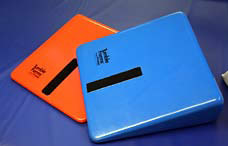Seating
There are several types of specialized seating. Wheelchairs and specialized strollers are used when a child’s temporary or permanent physical condition makes walking impossible, when walking is so difficult that it leaves no energy for other activities, or when the child needs to develop the motivation to get around.

There are many types of wheelchair designs: manual and self-propelled chairs can be light-weight or heavy-duty, have one-armed drive, or be lever-operated. Battery driven wheelchairs can be conventional, scooter-type, heavy-duty, or all-terrain.
Stroller/travel chairs are a type of specialized seating in which the child is pushed by another person. These strollers are sturdier than young children’s strollers and offer more head and neck support.
Other Mobility Aids
Mobility devices can provide support for a child to crawl, stand, or walk.
Crawling: Scooter boards can be propelled by the child’s arms as he lies across the board.
Standing: Many children with balance issues are unable to stand independently but can play if they are supported in a standing position. Sometimes children who cannot hold their heads up while lying down are able to hold their heads up when they are in a sitting or standing position.
Walking: A child with weak leg muscles may require braces to help support the joints. Even with bracing, a child may require a walker for trunk balance. Young children usually require walkers with front wheels as they require less energy to use than walkers without wheels.
Rolls and Wedges

For children who require support in developing control of the head, shoulders, arms, and hands, a small roll may be used. When placed under the chest, the roll makes lifting the shoulders or raising the head easier. Some children keep their arms close to their body because they don’t have enough control and balance to reach out their arm(s). The roll can also assist children to move their arms forward and reach out.

A wedge provides slanted support to help children work on head, shoulder, and arm control. The height of the wedge depends on the child’s needs. Lower wedges allow the child to lift up onto the elbows, while a higher wedge encourages arm and shoulder movement.
References:
Based on Parent Articles for Early Intervention, 1990, Communication Skill Builders, Inc.
